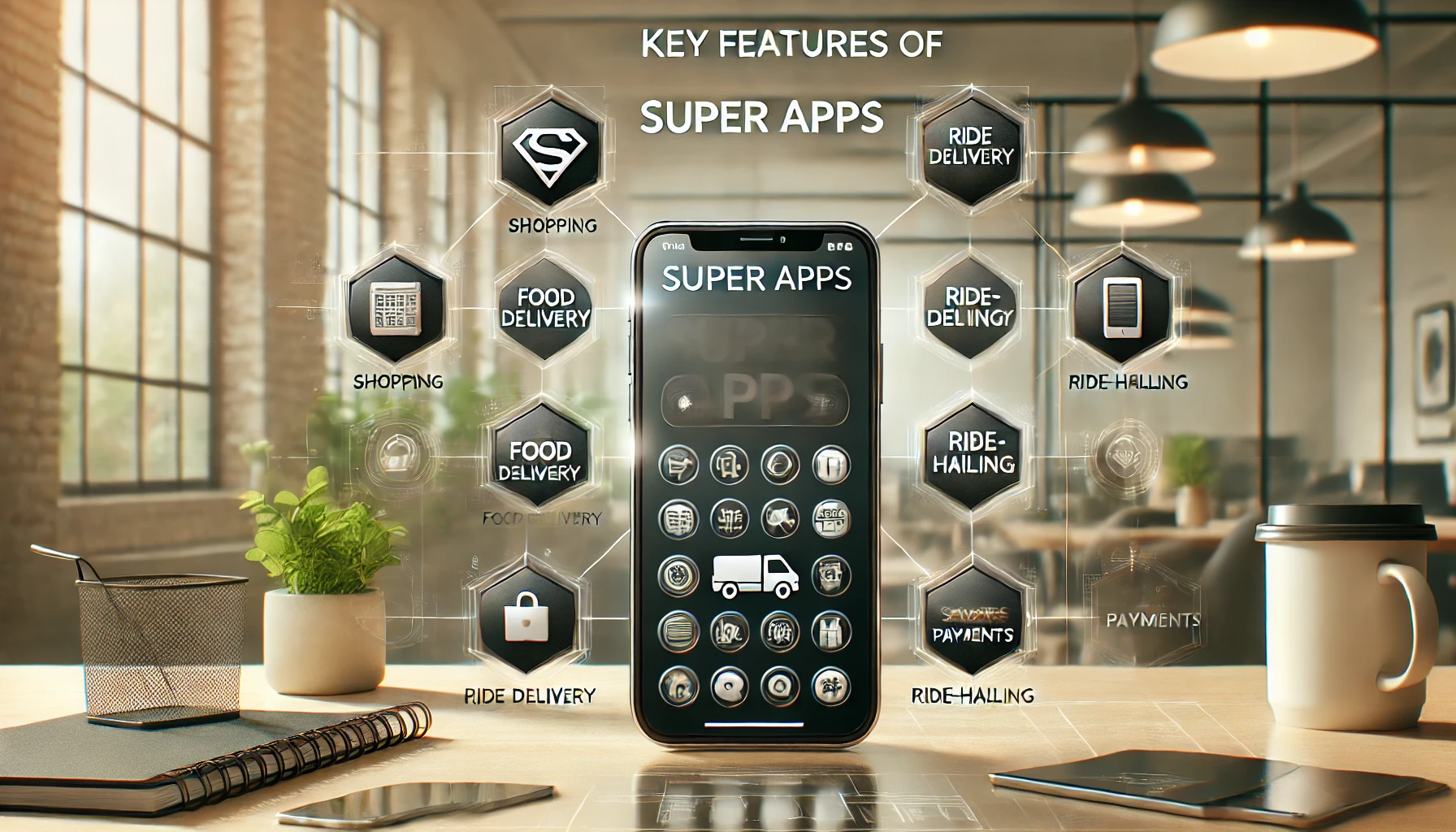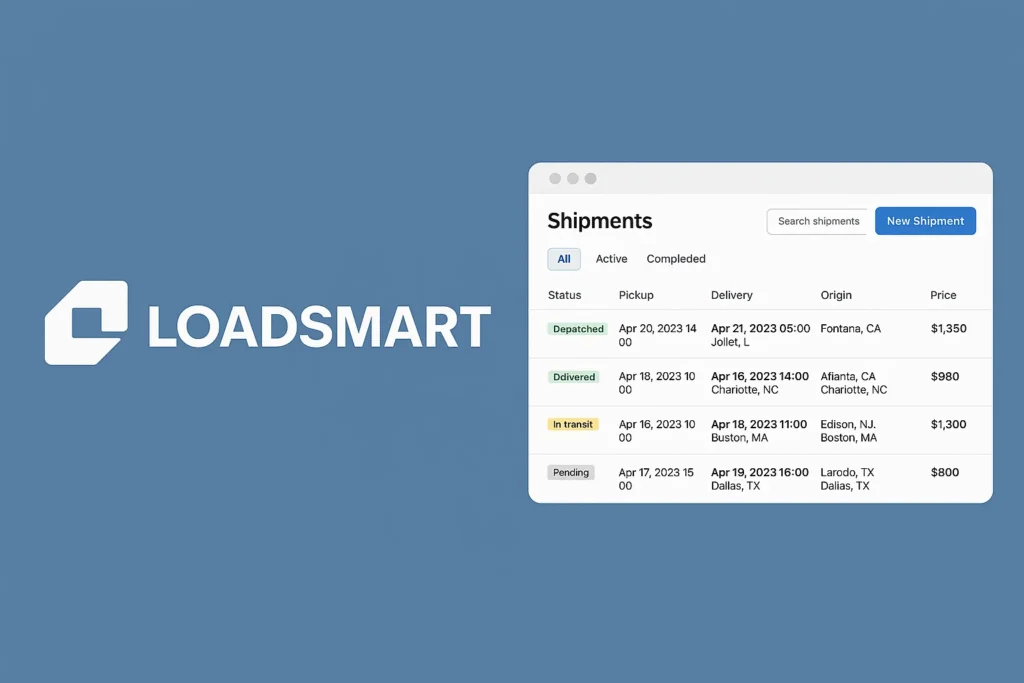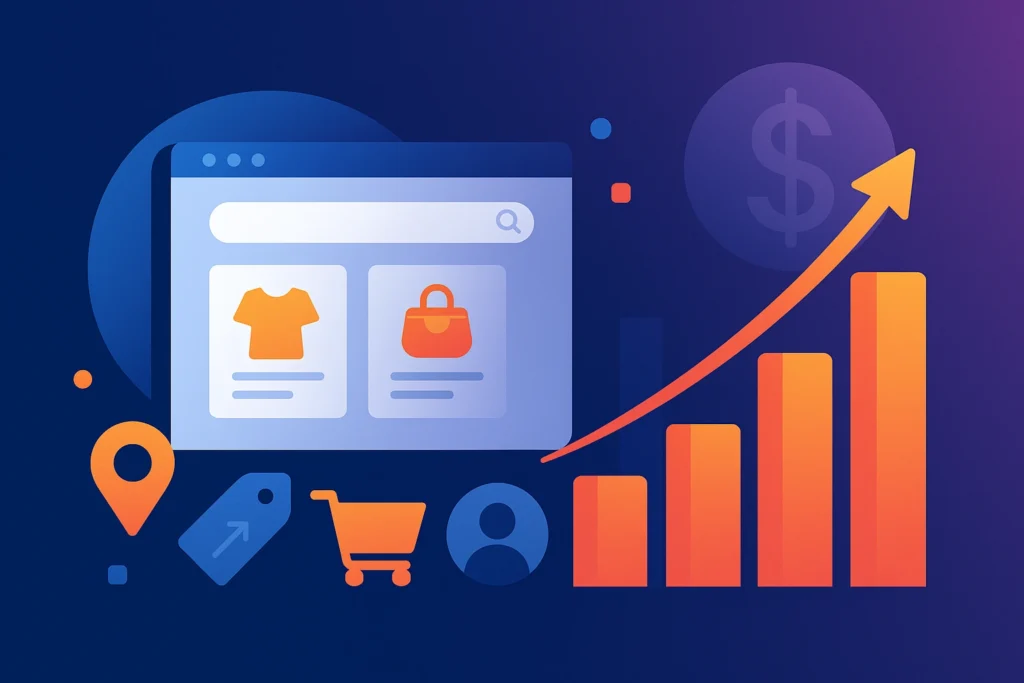As the digital landscape evolves, super apps have emerged as multi-functional platforms that integrate numerous services within a single application. Pioneered by companies like WeChat, Gojek, and Grab, these apps combine services ranging from ride-sharing to e-commerce, financial services, and social networking. Their success stems from key features that enable smooth service integration, a robust app architecture, and efficient management of multi-vendor operations. For businesses inspired by these success stories, building platforms modeled on a Grab clone or a Gojek clone can be an effective way to create versatile super apps. In this blog, we’ll explore the key features of super apps, focusing on essential components like ride-sharing, payment gateways, and service management.
Global Market of Super Apps: Key Facts
- Market Size (2024): The global market for super apps is expected to reach $500 billion by 2024, driven by increasing demand for convenience and all-in-one digital solutions.
- Compound Annual Growth Rate (CAGR): The market is growing at an estimated 23% CAGR from 2020 to 2024.
- Key Regions: The Asia-Pacific region leads the market, accounting for more than 45% of the global super app market, with countries like China, Indonesia, and India driving demand through apps like WeChat, Gojek, and Paytm.
- Primary Industries: Super apps cater to various industries including transportation, food delivery, e-commerce, digital payments, and financial services.
- Major Growth Drivers: The key factors driving market growth include rising smartphone penetration, increased adoption of digital payment systems, and growing demand for integrated services under a single platform.
By 2030, the superapp market is expected to exceed $1 trillion, with further growth opportunities arising from innovations in AI, blockchain, and financial technologies.
Learn More: Battle of the Super Apps: Gojek vs. Grab – Who Comes Out on Top?
Features Of Super App
Super apps thrive by offering users a wide array of services in one convenient location. Below are the critical features that make super apps successful:
a. Multi-Vendor App Integration
- Feature: A multi-vendor app allows multiple vendors to offer their services within the super app, whether it’s food delivery, ride-sharing, or e-commerce.
- Why It’s Important: Multi-vendor integration supports a variety of businesses and services, providing flexibility to users who can access everything from groceries to transportation within one app.
b. App Architecture and Scalability
- Feature: The app architecture of super apps is typically based on a microservices architecture. This allows the application to scale quickly and efficiently by adding or updating services without disrupting the entire app.
- Why It’s Important: Super apps need to scale seamlessly as they grow and add more services. A well-structured architecture ensures smooth functioning and scalability.
c. Service Integration
- Feature: Service integration enables different functionalities, such as ride-sharing, food delivery, and financial services, to operate cohesively within a single app. This involves integrating APIs, payment gateways, and third-party service providers.
- Why It’s Important: Users expect a seamless experience when switching between services. Proper service integration ensures that payments, notifications, and bookings happen smoothly across all services.
d. Ride-Sharing and Transportation
- Feature: A fundamental component of many super apps is ride-sharing services that allow users to book rides, carpools, or even bike taxis.
- Why It’s Important: Transportation services make super apps indispensable for users, especially in urban environments. Features such as real-time tracking, dynamic pricing, and driver ratings enhance the ride-sharing experience.
e. Payment Gateways and Digital Wallets
- Feature: Secure payment gateways and digital wallets are at the core of every super app. These allow users to make payments for a variety of services, whether it’s for food delivery, ride-sharing, or online shopping.
- Why It’s Important: Offering multiple payment methods—such as credit cards, digital wallets, and local payment solutions—enhances user convenience and trust in the platform.
f. Service and Vendor Management
- Feature: A vendor management system enables service providers to manage their offerings, track orders, and communicate with customers directly through the app.
- Why It’s Important: Efficient service management ensures that vendors can respond quickly to user needs, track performance, and optimize their services.
g. Customer Support and Feedback Systems
- Feature: In-app customer support and feedback systems allow users to communicate issues, ask for help, and leave reviews for services they’ve used.
- Why It’s Important: Quick and responsive customer support is vital for user retention. Feedback systems also help in improving the quality of services offered.
Learn more about complete guide about Super App Development
Comparison of Top Super Apps: Features of Gojek, WeChat, and Grab
| Feature | Gojek | Grab | |
| Multi-Vendor Integration | Supports various services including ride-sharing, food delivery, and courier | Primarily social and commerce with integrated payment services | Multi-service platform with focus on transportation, food, and financial services |
| App Architecture | Microservices architecture for scalability | Supports third-party mini-programs | Multi-layered architecture for rapid scaling |
| Ride-Sharing | Yes, includes bike taxis and car rides | No dedicated ride-sharing | Yes, a primary service alongside other offerings |
| Payment Gateways | Gopay for digital transactions | WeChat Pay for everything from bills to e-commerce | GrabPay for all service payments |
| Service Management | Vendors manage their services through the app | Allows integration of third-party apps | Vendors track and manage services for ride-sharing and food delivery |
| Customer Support | In-app chat and phone support | Chat-based support integrated with social features | In-app support with live chat and FAQs |
| Additional Features | Offers food delivery, courier services, and telemedicine | Messaging, e-commerce, and mini-programs for third-party services | Financial services, insurance, and rewards system |
How Service Integration Works in a Super App Framework
In a super app, service integration is the backbone that allows various functions like transportation, food delivery, and payments to work harmoniously together. Here’s how the integration typically works:
1. Microservices Architecture
- Explanation: Super apps utilize a microservices architecture, where each service (e.g., ride-sharing, payments, food delivery) operates independently yet communicates with other services. This allows for easy updates, additions, or removal of services without affecting the entire app.
2. API Integration
- Explanation: APIs (Application Programming Interfaces) are used to connect the super app to third-party service providers, allowing for real-time data exchange between users, vendors, and the platform. This enables smooth bookings, real-time tracking, and payment processing.
3. Payment Integration
- Explanation: Payment gateways are integrated into the app to ensure that all transactions happen within the app, providing users with a unified experience for booking rides, ordering food, or paying for groceries. Digital wallets allow users to store funds and earn rewards.
4. Centralized User Management
- Explanation: A centralized system manages user profiles, preferences, and service history. This means users can access all services under one account, whether they’re booking a ride, making a payment, or ordering food.
5. Vendor Management System
- Explanation: Service providers (e.g., drivers, restaurants, merchants) can manage their own accounts, update offerings, and communicate with customers directly within the app. This ensures efficient service delivery and user satisfaction.
Learn more about ‘Building Multi-Service Apps from Scratch‘ in this section.
Benefits of Building a Super App
Building a super app offers numerous advantages to businesses, developers, and end-users. Here are the key benefits:
1. Increased User Engagement and Retention
- Benefit: Super apps keep users engaged by providing multiple services within a single platform. From ride-sharing and food delivery to payments and shopping, users don’t need to switch between multiple apps to get what they need.
- Why It Matters: By catering to various needs in one place, super apps increase the likelihood of users returning to the app, improving customer retention rates.
2. Streamlined User Experience
- Benefit: Super apps offer a unified experience across all services, which reduces the hassle for users. Having a single login, payment method, and user profile for different services simplifies the experience.
- Why It Matters: Users appreciate a smooth, efficient process when using apps. The easier it is to navigate the services, the more likely they are to use the app for various activities.
3. Monetization Opportunities
- Benefit: Super apps open up multiple revenue streams, such as commission-based earnings from vendors, subscription models, and in-app advertisements.
- Why It Matters: Offering diverse services allows businesses to monetize in several ways, including charging service fees, earning commissions on transactions, and offering premium services.
4. Reduced Customer Acquisition Costs
- Benefit: Instead of acquiring users for individual services (e.g., a separate app for ride-hailing or food delivery), businesses can attract and retain users for multiple services within one app.
- Why It Matters: This reduces the overall customer acquisition cost (CAC) as users can access different services under one platform without the need for multiple marketing campaigns.
5. Scalability and Expansion
- Benefit: With a microservices architecture, super apps can easily scale and add new services as needed without disrupting existing ones.
- Why It Matters: This scalability allows businesses to expand their offerings quickly, keeping pace with user demand and technological advances. It also enables super apps to enter new industries like healthcare, education, or finance seamlessly.
6. Data Collection and Personalization
- Benefit: By offering a wide range of services, super apps collect valuable data on user behavior and preferences. This data can be used to personalize recommendations, improve services, and drive user engagement.
- Why It Matters: Personalized experiences keep users engaged, increase user satisfaction, and enhance app loyalty. Leveraging data also helps businesses optimize their service offerings.
7. Vendor and Partner Ecosystem
- Benefit: Super apps create an ecosystem where vendors, service providers, and third-party developers can integrate their services, expanding the app’s reach and service offerings.
- Why It Matters: A healthy partner ecosystem enhances the value of the app, as more services attract more users. This creates a mutually beneficial environment for both service providers and the platform.
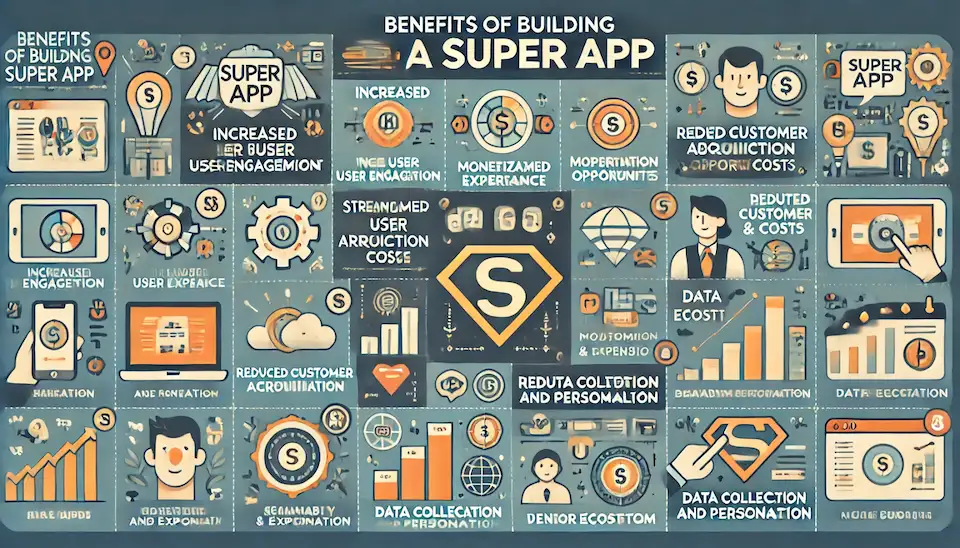
Cost of Making a Super App
The cost of developing a super app depends on various factors, including the number of services offered, the complexity of features, and the location of the development team. Below is an estimated cost breakdown for each major component of super app development:
| Development Component | Estimated Cost (USD) | Description |
| App Architecture & Backend | $20,000 – $50,000 | Developing a scalable microservices-based architecture and backend systems. |
| UI/UX Design | $10,000 – $30,000 | Designing a user-friendly interface for seamless navigation across services. |
| Core Features Integration | $30,000 – $70,000 | Integration of core services like ride-sharing, food delivery, and payment gateways. |
| Multi-Vendor Management System | $15,000 – $30,000 | Developing a system for managing multiple vendors and service providers. |
| Payment Gateway & Digital Wallet | $15,000 – $40,000 | Integration of secure payment gateways and digital wallets for transactions. |
| Service-Specific Features | $20,000 – $50,000 | Features like real-time tracking, notifications, and dynamic pricing for services such as ride-hailing and deliveries. |
| Testing & Quality Assurance | $10,000 – $25,000 | Rigorous testing for usability, performance, and bug fixes. |
| Deployment & Maintenance | $5,000 – $15,000 | Initial deployment to app stores and ongoing maintenance. |
Total Estimated Cost: $125,000 – $310,000
This is an estimated cost range and can vary based on additional features, complexity, and the geographical location of the development team.
At Miracuves Solutions, super app development services start from just $1899, offering a cost-effective solution for businesses looking to enter the super app market.
Super App Launch Timeline
Developing and launching a super app requires strategic planning and coordination across various stages. Here is an estimated timeline for building and launching a super app:
| Phase | Tasks | Estimated Duration |
| 1. Planning & Research | Market research, competitor analysis, feature specification | 2 – 4 weeks |
| 2. App Architecture & Design | Design app architecture, create wireframes, UI/UX design | 4 – 6 weeks |
| 3. Core Development | Develop the backend, APIs, and core features for each service | 8 – 12 weeks |
| 4. Service Integration | Integrate ride-sharing, payments, food delivery, and other services | 6 – 8 weeks |
| 5. Testing & QA | Comprehensive testing for bugs, security, performance | 4 – 6 weeks |
| 6. Deployment & Launch | Deploy to app stores, run marketing campaigns, gather feedback | 2 – 4 weeks |
| 7. Post-Launch Maintenance | Monitor performance, resolve bugs, and update based on feedback | Ongoing |
Total Estimated Timeline: 26 – 40 weeks
The timeline may vary depending on the complexity of the app, the number of services being integrated, and the size of the development team.
At Miracuves Solutions, we ensure a streamlined process, reducing time-to-market and offering expert guidance throughout the development and launch phases.
Ready to Launch the Next Big Super App?
Bring ride-hailing, payments, food delivery & shopping
together in one powerful platform. Let’s turn your
idea into a game-changing app today!
Marketing Strategy for Launching a Super App
Launching a super app requires a well-planned and multi-faceted marketing strategy to create awareness, attract users, and drive early adoption. Here’s a comprehensive marketing strategy to ensure a successful launch:
1. Pre-Launch Marketing
a. Build Hype with Teasers and Announcements
- Action: Use social media, blogs, and email newsletters to create curiosity around your super app before its official launch.
- Why It Matters: This builds anticipation and encourages potential users to sign up for early access or notifications.
b. Influencer and Media Outreach
- Action: Partner with influencers and bloggers in your target industry to talk about the app and its upcoming launch. Send out press releases to industry media for broader coverage.
- Why It Matters: Influencers can tap into their audience base, generating more interest and trust in the app before the official launch.
c. Beta Testing with Early Adopters
- Action: Offer beta versions of the app to a select group of users in exchange for feedback.
- Why It Matters: Not only does this help refine the app’s features, but early adopters can also become brand advocates, helping spread word-of-mouth buzz.
2. Launch Marketing
a. Social Media Campaigns
- Action: Run targeted ad campaigns on platforms like Instagram, Facebook, LinkedIn, and TikTok. Showcase the key features of the super app and offer incentives for downloading (e.g., first-time ride or service discounts).
- Why It Matters: Social media is key to reaching your target audience quickly and driving app downloads. Special offers and discounts can boost early adoption.
b. App Store Optimization (ASO)
- Action: Optimize your app’s title, description, keywords, and visuals in both the Apple App Store and Google Play Store to improve search visibility.
- Why It Matters: App store optimization ensures that potential users can easily discover your app when searching for services you offer (e.g., ride-hailing, food delivery).
c. Referral Programs
- Action: Implement a referral program where users can invite friends to download the app in exchange for rewards (e.g., free rides or discounts on services).
- Why It Matters: Referral marketing leverages existing users to drive growth, providing a cost-effective way to boost downloads and user engagement.
3. Post-Launch Marketing
a. Continuous Social Proof and User Reviews
- Action: Encourage users to leave positive reviews on app stores and social media, and showcase testimonials from early adopters.
- Why It Matters: Positive reviews and user-generated content help build trust, encouraging more users to download the app.
b. Loyalty Programs
- Action: Create a loyalty or rewards program to incentivize repeat use of the app’s services (e.g., points for each transaction that can be redeemed for future discounts).
- Why It Matters: Loyalty programs increase retention, keeping users engaged and coming back to the app regularly.
c. Partner with Local Businesses
- Action: Collaborate with local restaurants, ride-share drivers, and service providers to promote your app to their customers, offering special deals.
- Why It Matters: Local partnerships help expand the app’s user base organically and create strong brand affiliations within the community.
4. Targeted Campaigns for Specific Services
a. Promote Key Services with Niche Marketing
- Action: Run campaigns specifically targeted at individual services (e.g., a special promotion for food delivery users or discounted rides for first-time users).
- Why It Matters: Niche campaigns help focus on specific user needs and allow you to tailor your marketing messages for better conversion.
b. Seasonal Promotions
- Action: Create limited-time offers during special events or holidays to drive usage (e.g., holiday season sales, New Year’s deals).
- Why It Matters: Seasonal promotions boost short-term user acquisition and engagement, especially during high-demand periods.
5. Analytics and Performance Tracking
a. Data-Driven Marketing
- Action: Use analytics tools like Google Analytics, Firebase, or Appsflyer to track user behavior, app usage, and marketing campaign performance.
- Why It Matters: Data-driven insights allow you to adjust your marketing strategies in real-time, optimizing your campaigns for maximum effectiveness.
b. Retargeting Campaigns
- Action: Use retargeting ads to reach users who have downloaded the app but haven’t yet used any services, offering them incentives to engage.
- Why It Matters: Retargeting helps re-engage users who may have downloaded the app but haven’t fully interacted with it, turning them into active users.
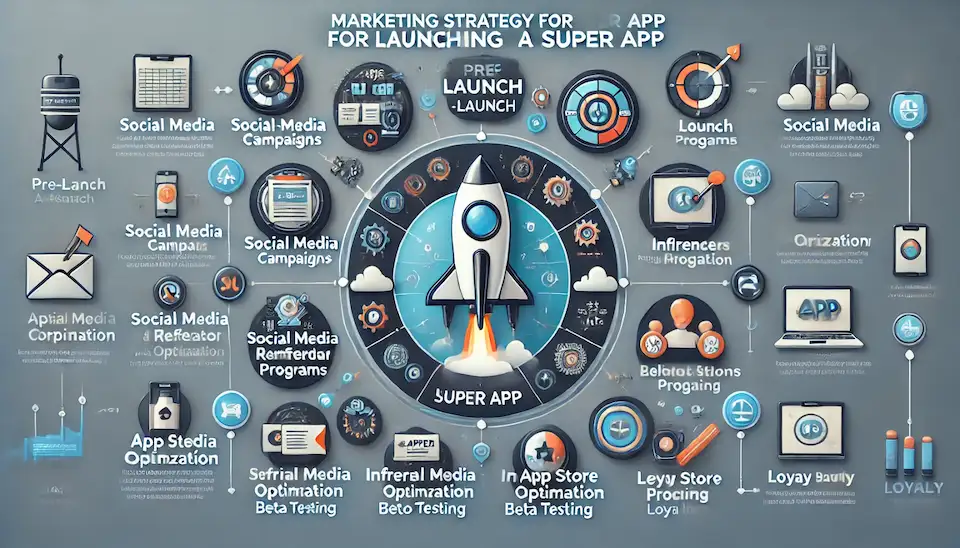
Final Thoughts
Super apps have become a dominant force in the digital landscape, offering users an all-in-one platform that integrates a wide array of services—from ride-sharing and food delivery to financial transactions and e-commerce. As the global market for super apps continues to expand, businesses have an unprecedented opportunity to tap into this growing sector. With projected market growth to reach $500 billion by 2024 and even exceed $1 trillion by 2030, the future of super apps looks incredibly promising.
For businesses and developers, creating a super app is not just about offering multiple services; it’s about delivering convenience, scalability, and user satisfaction. Leveraging the right app architecture, service integration, and a well-planned marketing strategy can help establish a successful super app that thrives in a competitive market.
Ready to create your own Super App?
Request a demo to see how our platform integrates multiple features like payments, ride-hailing, food delivery, and more into one seamless app—just like the biggest super apps out there!
FAQs
What are the essential features of a super app?
A super app integrates multiple services within one platform, offering key features like seamless payment integration, ride-hailing, food delivery, and social networking. These apps provide a unified user experience, personalized recommendations, and secure payment gateways, making them a one-stop solution for users’ daily needs.
How do super apps enhance user convenience?
Super apps simplify life by offering multiple services under one roof, eliminating the need to download and manage multiple apps. Features such as cross-service loyalty programs, in-app messaging, and location-based services ensure users have everything they need within a single, streamlined platform.
Why are super apps considered the future of mobile app development?
Super apps are gaining popularity due to their ability to cater to diverse user needs, offering a unified ecosystem for services like e-commerce, banking, and travel. Their versatility, robust API integrations, and enhanced user engagement are making them a preferred choice for enterprises looking to drive growth and customer retention.
Check out our popular super app solutions offered by Miracuves – built for versatility, performance, and scale:
- Gojek Inspired App– A powerful all-in-one super app offering ride-hailing, food delivery, courier, payments, and more
- Glovo Inspired App – An on-demand delivery app covering food, groceries, pharmacy, and courier services in one platform
- Grab Inspired App– A comprehensive app solution combining transportation, delivery, digital payments, and everyday services



